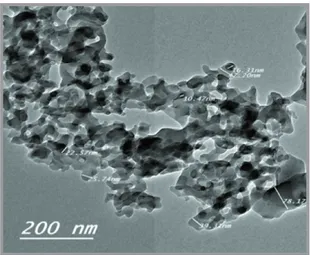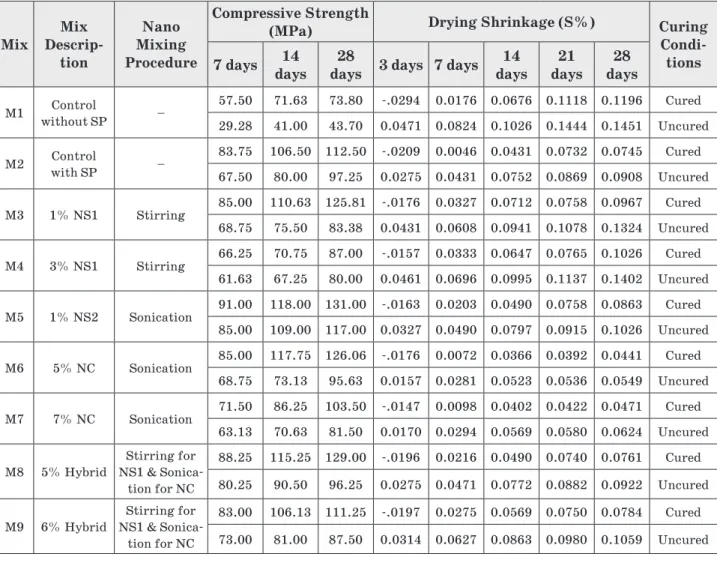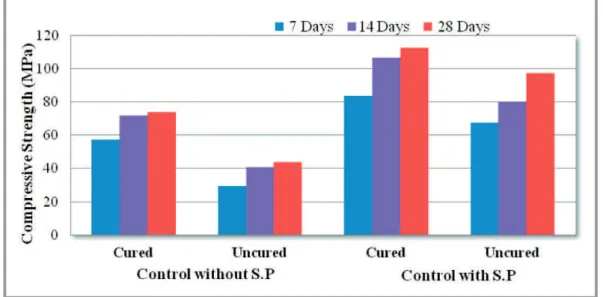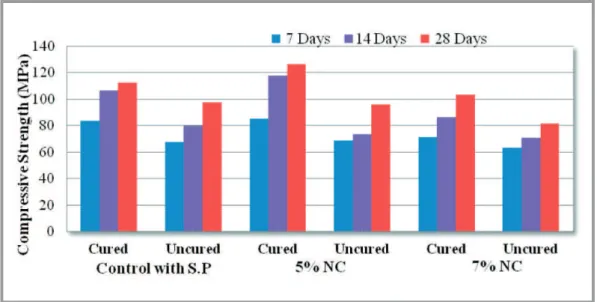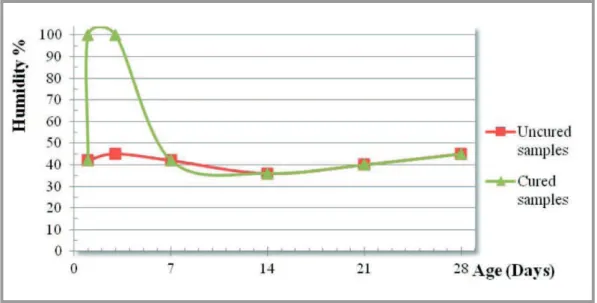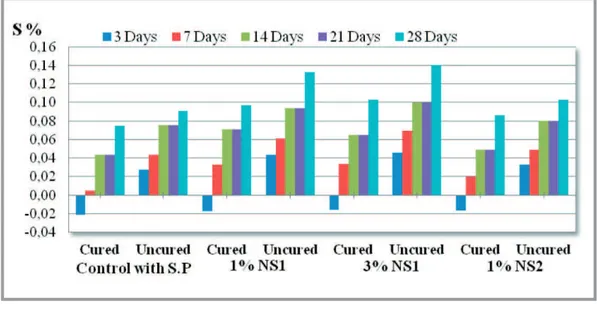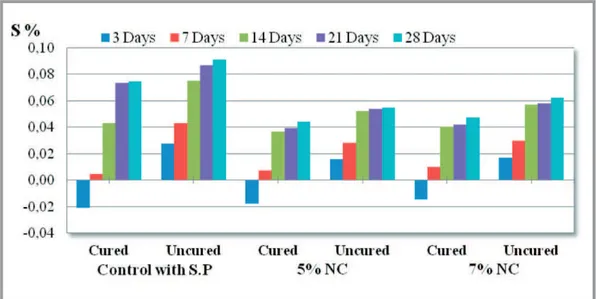Author: : Saaid I. ZAkI, Professor in Hosing and Building National Research Center HBRC , Cairo , Egypt ; Tahreer street, 87, dokki, Cairo, Egypt; 11511, Post box no 1770, saaid_zaki@yahoo;
Author: Hossam A. HoDHoD, Professor in Faculty of Engineering Cairo University, Cairo, Egypt; Tahreer street, 87, dokki, Cairo, Egypt; 11511, Post box no 1770, saaid_zaki@yahoo;
Author: Mostafa A. MAHDI, Assistant Lecturer in Faculty of Engineering, Misr University for Science and Technology, Giza, Cairo , Egypt ; Tahreer street, 87, dokki, Cairo, Egypt; 11511, Post box no 1770, saaid_zaki@yahoo.
THE EFFECT OF USING HYBRID NANOMATERIALS ON DRYING
SHRINKAGE AND STRENGTH OF CEMENT PASTES
ExtEndEd AbstrAct:
The aim of this work is to study the effect of nanomaterials on the properties of cement paste, the experimental program included three parts: a- two types of nanosilica, locally produced NS1 and imported NS2, b- nanoclay (NC) and c- Hybrid nanoparticles (NS1 & NC). In each part, cement paste was used with different percentages of nanoparticles. Com-pressive strength and drying shrinkage tests were applied in each part on the cured and uncured samples. The results showed that the compressive strength improved in the cement paste mixtures in the cured condition, the optimum percentages was 1% for NS1, 1% for NS2, 5% for NC, and 5% (0.5%NS1 & 4.5%NC) for hybrid nanoparticles. The drying shrinkage in-creases with adding nanosilica and hybrid nanoparticles, while it dein-creases when adding NC.
key words: nanosilica, nanoclay, hybrid nanomaterials.
MAchinE-rEAdAblEinforMAtionon cc-licEnsEs (htMl-codE) inMEtAdAtAofthEpApEr
<a rel=»license» href=»http://creativecommons.org/licenses/by/4.0/»><img alt=»Creative Commons License» style=»border-width:0» src=»https://i.creativecommons.org/l/by/4.0/88x31.png» /></a><br /><span xmlns:dct=»http://purl.org/ dc/terms/» href=»http://purl.org/dc/dcmitype/Text» property=»dct:title» rel=»dct:type»>The effect of using hybrid nanomaterials on drying shrinkage and strength of cement pastes </span> by <a xmlns:cc=»http://creativecommons.org/ ns#» href=»Nanotehnologii v stroitel’stve = Nanotechnologies in Construction. 2016, Vol. 8, no. 2, pp. 109–134. DOI: dx.doi. org/10.15828/2075-8545-2016-8-2-109-134» property=»cc:attributionName» rel=»cc:attributionURL»>Zaki Saaid I., Hossam A. Hodhod, Mostafa A. Mahdi. </a> is licensed under a <a rel=»license» href=»http://creativecommons.org/licenses/ by/4.0/»>Creative Commons Attribution 4.0 International License</a>.<br />Based on a work at <a xmlns:dct=»http:// purl.org/dc/terms/» href=» http://nanobuild.ru/en_EN/nanobuild-2-2016/» rel=»dct:source»> http://nanobuild.ru/ en_EN/nanobuild-2-2016/</a>.<br />Permissions beyond the scope of this license may be available at <a xmlns:cc=»http:// creativecommons.org/ns#» href=»saaid_zaki@yahoo» rel=»cc:morePermissions»>saaid_zaki@yahoo</a>.
1. Introduction
Previous researches concerning the effect of hybrid nanomaterials on the drying shrinkage of cement pastes, mortars and concretes are so lim-ited, as most of the following previous researches deals mainly with the dispersion issue and the influence of hybrid nanomaterials, NS and NC on the properties of fresh and hardened states.
M.A. Mahdi [1] (2015) studied the Effect of Using Nanomaterials on the Properties of Cement Paste and Mortar, He found that the compres-sive strength improved in the mixtures in the cured condition, the op-timum percentages was 1% for nano silica, 5% for nano clay, and 5% (0.5%NS&4.5%NC) for hybrid nanoparticles. The drying shrinkage and thermal conductivity increase with adding NS and Hybrid, while they de-crease when adding NC.
A.M. Mohamed [2] (2014) studied the Influence of Nanomaterials on Compressive Strength of Concrete, he added nano silica, nano clay or both together with different percentages to the mixes. He found that, NS is more effective than NC and wet mix gives higher efficiency than dry mix. Adding NS and NC together in the mix had a remarkable improvement ap-pearing in concrete compressive strength than using the same percentage of one type. The optimum percentages were 3% nanoparticles consisting of 25% NS and 75% NC for compressive strength.
that using nanoparticles improves the mechanical properties of concrete mixes. The optimum percentage of NS and NC was 5%, and for hybrid was 2.5%NS & 2.5%NC. Dry mix gives the best dispersion of nanopar-ticles and less weak points of the inert materials in the mix compared to wet mix.
M.S. Morsy, et al [4] (2010) studied the Hybrid Effect of Carbon Nano-tube and Nano-Clay on Physico-Mechanical Properties of Cement Mortar, They found that adding 6% NC in cement mortar increases compressive strength by 18%. The addition of CNTs (up to 0.02%) to NC cement mor-tar improves the compressive strength of the composites with 11% higher than mix containing 6% NC, while the addition of CNTs by 0.1% decreased the compressive strength.
H. Yang [5] (2012) studied the bending tensile Strength and Shrinkage Property of Nano Silica Powder Concrete; He found that when proper con-tent of NS is added to concrete, bending tensile strength can be improved but this leads to higher shrinkage rate, easily producing early crack.
A. Sadrmomtazi, et al [6] (2010) studied the effect of Polypropylene fibers on the mechanical and physical properties of mortars containing nano-SiO2. Compressive, flexural strength and shrinkage were measured. They found that adding NS to fiber reinforced cement composites im-proved the mechanical characteristics of mortars, but increases shrink-age rate.
Tobon J.I., et al [7] (2010) Analyzed the Performance of Portland Ce-ment Blended with Nano Silica and Silica Fume, measuring the physical properties cement type III replaced with1, 3, 5 and 10% NS and silica fume in percentages of 5, 10 and 15%. They found that 5% NS improves in com-pressive strength with 10% after 3 days of curing, while 5% and 10% NS improve in compressive strength with 10% and 80% respectively after 28 days of curing.
J.S. Belkowitz1, et al [8] (2010) investigated Nano Silica in the Cement Hydration Process determining the compressive strength. They found that different sizes of silica improve some properties. When the silica particle size increases, the rate of early pozzolanic reaction decreases. Both nano and micron size silica particles were added at the same concentration, but the nano silica was more effective.
nano-SiO2 percentage ranges between 5% and 7%. Adding nano-SiO2 increased drying shrinkage and decreased the water absorption of cement composites by the pozzolanic effects and filling the pores, this leaded to reduction of permeability more than when SF is used.
L. Senff, et al [10] (2009) studied adding Amorphous nano-silica par-ticles (0–2.5 wt%) to cement pastes and mortars. They found that NS mod-ified the characteristics of fresh mortars. The presence of NS decreased the amount of lubricating water available in the mixture and yield stress increases considerably.
A. Hakamy, et al [11] (2014) investigated the Characteristics of Hemp Fabric Reinforced Nano clay–Cement Nano composites; they found that, the optimum content of NC was 1%. The HF-reinforced nano composites containing 1wt% NC decreased the porosity (15.5%) and also increased the density (5.3%), flexural strength (26.2%) and fracture toughness (24.9%). Adding more than 1% NC to the HF-reinforced cement composites affects negatively the fracture toughness and the flexural strength.
K. Patel [12] (2012) studied the use of Nano clay aiming to constitute blended cement mortar with fractional increase in mechanical strength. They found the compressive strength was improved by 300% with 1% NC and by 290% with 2% NC for seven day testing. At the age of 28 day the improvement reached 310% with 1% NC and 200% with 2% NC.
M.S. Morsy, et al [13] (2010) studied the effect of Nano-clay on me-chanical properties and microstructure of ordinary Portland cement mor-tar. NC was added with percentages of 0, 2, 4, 6 and 8% by weight of ce-ment. The samples were first cured at 100% relative humidity for 24 hours and then cured in water for 28 days. The enhancement in compressive was 7% at 8% NC.
The purpose of this research is to study the effect of adding nano sil-ica, nano clay and hybrid nanoparticles with different percentages to the cement paste to study their effect on compressive strength and drying shrinkage under different curing conditions.
2. Experimental Work
2.1 Materials. 2.1.1- Cement.
Ordinary Portland cement (OPC) (CEM1 52.5 N) was used during the study, obtained from Beni-Suef Cement Factory in Egypt. The chemical analysis of the cement is shown in Table 1.
2.1.2 Chemical Admixture.
High performance superplasticizer (S.P) (Glenium ACE 30) was used which is an aqueous solution of modified Polycarboxylates, obtained from BASF Chemicals Company in Egypt.
2.1.3 Nano Powders.
Nano powders are two nano silica types (NS1 & NS2) and nano clay.
2.1.3.1 Nano Silica.
The first type one of nano silica (NS1) is produced locally in nanoma-terials laboratory on Beni-Suef University; it is characterized by 38 nm of the mean particle size and 110 m2/g of surface area, it consists of pure
sili-ca. Fig. 1. shows the Transmission Electron Microscope (TEM) micrograph of NS1 with magnification 200k x.
The second type two of nano silica (NS2) is imported from Sigma-Al-drich Company in Germany; it is characterized by 24 nm of the mean parti-cle size and 220 m2/g of surface area, it consists of pure silica. Fig. 2. shows
the TEM micrograph of NS2 with magnification 150 k x.
2.1.3.2 Nano Clay.
Nano clay (NC) is montmorillonite clay (OH4 Si8 AL4 O20n) was obtained from Middle East Mining Investments Company in Egypt (MEMCO) modi-fied with quaternary ammonium salts (sodium calcium aluminum silicate) that is in crystalline state which is characterized by large length accord-ing to its thickness ratio. The nano clay used in this research was in an amorphous state. Thermal activation which was performed converted the nano clay crystalline state to amorphous state; it reduced the grain size of nano clay. The clay was exposed to 800oC temperature for two hours.
2.2 Mix design and preparation of specimens.
Standard cement paste was prepared according to ESS (2421-1993) [14] to determine the standard water – cement ratio , which was found in this study 20% for all mixes with S.P and 30% for mix M1 without S.P. superplasticizer changed from (1 to 1.5) % of cement to maintain the same water-cement ratio for all mixes.
2.2.1 Mix design.
Cement pastes were prepared, mixed, casted, cured and tested in the Material Laboratory in the Faculty of Engineering, Cairo University, nine cement paste mixes were designed and shown in table 3 , from which it can be noticed that mix M1 and M2 were control mixes with and with-out S.P, while mixes M3, M4 and M5 were with different percentages of nano silica(1%, 3%), mixes M6 and M7 were with different percentages of nano clay (5%, 7%), mixes M8 and M9 were with different percent-ages of hybrid nanomaterials (5%, 6%) as weight percentage of cement content.
2.2.2 Dispersion techniques of nanoparticles.
To achieve perfect dispersion of nanoparticles to enhance the base ma-trix, two dispersion techniques are used in this study: a- Sonication, b- Stir-ring by vane motor.
2.2.2.1 Sonication.
Water bath sonicator shown in Fig. 4 has been used. Nanoparticles were mixed with half amount of the water and superplasticizer.
This technique was applied with nano silica and the period of sonica-tion was 5 minutes, while it was 10 minutes when nano clay was used, the temperature was 40oC. Table 4. shows the specifications of water bath
soni-cator.
2.2.2.2 Stirring by vane motor.
2.2.3 Mixing Procedure.
The cement and half amount of the water and SP needed for the mix-ture were mixed in a rotary mixer for thirty seconds. The ready mixed liquid (The other half of the water and SP amount and the nanoparticles) that resulted from the nano dispersion technique was added gradually and mixed for additional three minutes.
2.2.4 Casting and Curing Procedure.
The mixtures were casted in steel mold contains 30 cube of dimensions (20x20x20) mm for compressive strength, and a mold contain 5 prisms of dimensions (25x25x285) mm was used for shrinkage measurements.
After one day from casting, samples have been demolded. There were two curing systems carried out: a- cured in tap water, b- uncured in open air. All these samples were tested after 3, 7 and 28 days.
2.3 Testing Procedures.
2.3.1 The Compressive Strength.
The compressive strength of cement paste cubes was determined using SHIMADZU 500 KN Universal machine in Material laboratory in the Fac-ulty of Engineering, Cairo University.
2.3.2 The Drying Shrinkage.
Drying shrinkage has been calculated according to references [15, 16], using the samples demolded from the prisms by measuring the change in their length using the Micrometer. The samples extracted from the prisms were 25x25x285 mm with two nails fixed at their two ends; the length be-tween their internal edges was 250±2.5 mm. After demolding the samples, the change in their length from the two edges of the nails has been mea-sured (Lo). Then cured samples have been submerged in tap water for only forty eight hours, while uncured samples were left in the open air. After lifting the cured samples from the water, they have been left in the open air till the date of testing. Change of their length has been measured at ages: 3, 7, 14, 21 and 28 from the age of casting (Lf). Ages of measuring have been the same for the uncured samples (Lf).
, (15)
where,
• S%: Drying shrinkage strain.
• L: The effective length of the testing samples which is 250 mm accord-ing to [15].
• Lo: The length between the two nails edges after 24 hours. • Lf: The length between the two nails edges at each age.
Table 1. Chemical analysis of materials
Table 2. Physical properties of nanoparticles
% NC NS2 NS1 CEM I 52.5
SiO2 19.8 99.1 99.1 61.24
Al2O3 5.5 – – 20.89
CaO 63 – – 0.16
MgO 1.2 – – 0.22
Fe2O3 3.4 – – 1.06
Na2O 0.64 – – 0.71
K2O 0.19 – – 1.61
SO3 3 – – 0.17
L.O.I 2.5 – – 13.12
Nano Type Colour BulkDensity (g/cm3)
Mean Particle Size
(nm)
Surface Area (m2/g)
NS1 White 0.24 38 110
NS2 White 0.16 24 220
Table 3. Chemical analysis of materials
Mix Mix type
Nano Dispersion Technique
Cement (kg/m3)
Water (cm3/m3)
S.P (cm3/m3)
Nano weight (kg/m3)
W/b
M1 Control
without S.P – 2250 675 – – 0.3
M2 Control
with S.P – 2250 450 1% = 22.5 – 0.2
M3 1%NS1 Stirring 2227.5 450 1.25% = 28.125 22.5 0.2
M4 3%NS1 Stirring 2182.5 450 1.25% = 28.125 67.5 0.2
M5 1%NS2 Sonication 2227.5 450 1.25% = 28.125 22.5 0.2
M6 5%NC Sonication 2137.5 450 1.25% = 28.125 112.5 0.2
M7 7%NC Sonication 2092.5 450 1.5% = 33.75 157.5 0.2
M8
0.5%NS1 & 4.5%NC (5% Hybrid)
Stirring for NS1 & Sonication
for NC
2137.5 450 1.5% = 28.125 NS1 = 11.25 NC = 101.25 0.2
M9
1%NS1 & 5%NC (6% Hybrid)
Stirring for NS1 & Sonication
for NC
2115 450 1.5% = 28.125 NS1 = 22.5
NC = 112.5 0.2
Table 4. Specifications of water bath sonicator
Table 5. Specifications of vane motor
Volume (L) 6
Power supply (V) 220
Frequency (Hz) 50
Power consumption (watt) 200
Timer (Minute) 1-30
Speed range (rpm) 1500-2800
Frequency (Hz) 50
Fig. 1. TEM micrograph of NS1
Fig. 4. Water bath sonicator
Fig. 3. TEM micrograph of NC
Fig. 2. TEM micrograph of NS2
At each age, the average of the drying shrinkage percentage (S%) has been calculated for the six (cured and uncured) samples, in addition to mea-suring humidity and temperature.
3. Analysis and Discussion of Test Results
Table 6. shows the compressive strength test results of cement paste mixtures with and without nanoparticles at the ages of 7, 14 and 28 days for both cured and uncured mixtures, and drying shrinkage test results with and without nanoparticles at the ages of 3, 7, 14, 21 and 28 days.
Table 6. Compressive strength and drying shrinkage of cement paste samples
with and without nanoparticles
Mix Mix Descrip-tion Nano Mixing Procedure Compressive Strength
(MPa) Drying Shrinkage (S%) Curing
Condi-tions 7 days 14
days
28
days 3 days 7 days 14 days 21 days 28 days M1 Control
without SP –
57.50 71.63 73.80 -.0294 0.0176 0.0676 0.1118 0.1196 Cured 29.28 41.00 43.70 0.0471 0.0824 0.1026 0.1444 0.1451 Uncured
M2 Control
with SP –
83.75 106.50 112.50 -.0209 0.0046 0.0431 0.0732 0.0745 Cured 67.50 80.00 97.25 0.0275 0.0431 0.0752 0.0869 0.0908 Uncured
M3 1% NS1 Stirring 85.00 110.63 125.81 -.0176 0.0327 0.0712 0.0758 0.0967 Cured 68.75 75.50 83.38 0.0431 0.0608 0.0941 0.1078 0.1324 Uncured
M4 3% NS1 Stirring 66.25 70.75 87.00 -.0157 0.0333 0.0647 0.0765 0.1026 Cured 61.63 67.25 80.00 0.0461 0.0696 0.0995 0.1137 0.1402 Uncured
M5 1% NS2 Sonication 91.00 118.00 131.00 -.0163 0.0203 0.0490 0.0758 0.0863 Cured 85.00 109.00 117.00 0.0327 0.0490 0.0797 0.0915 0.1026 Uncured
M6 5% NC Sonication 85.00 117.75 126.06 -.0176 0.0072 0.0366 0.0392 0.0441 Cured 68.75 73.13 95.63 0.0157 0.0281 0.0523 0.0536 0.0549 Uncured
M7 7% NC Sonication 71.50 86.25 103.50 -.0147 0.0098 0.0402 0.0422 0.0471 Cured 63.13 70.63 81.50 0.0170 0.0294 0.0569 0.0580 0.0624 Uncured
M8 5% Hybrid
Stirring for NS1 &
Sonica-tion for NC
88.25 115.25 129.00 -.0196 0.0216 0.0490 0.0740 0.0761 Cured 80.25 90.50 96.25 0.0275 0.0471 0.0772 0.0882 0.0922 Uncured
M9 6% Hybrid
Stirring for NS1 &
Sonica-tion for NC
3.1 Compressive strength.
3.1.1 The effect of addition superplasticizer (S.P) on compressive strength.
Fig. 6. shows that when S.P was added to the cement paste, the enhance-ment in the workability and compressive strength at all ages was clear in the cured and uncured samples compared to the mixtures without S.P. this can be attributed to the reduction in water cement ratio. The percent of im-provement in compressive strength for control cured and uncured mortar mixture with S.P are 52.5% and 122.6% respectively at 28 days compared to control mixes.
3.1.2 The effect of adding NS1 and NS2 on compressive strength. Fig. 7. shows the development of compressive strength for control ce-ment paste mixes with S.P and mixes with different percentages of nano silica, it can be seen that the addition of 1%NS1- locally produced – using stirring dispersion technique to mixes increased the compressive strength compared to control ones for cured samples at all ages, the improved per-centages of compressive strength reached 1.49%, 3.88%, and 11.83% at 7, 14, and 28 days respectively, while the uncured samples with 1% NS1 showed a decrease in the compressive strength compared to the uncured control mixture with S.P.
The increase in the compressive strength can be attributed to the effi-ciency of nanoparticles in promoting pozzolanic reaction, packing the voids and consuming calcium hydroxide crystals forming additional calcium sili-cate hydrate (C–S–H).
When the NS1 percentage was increased to 3%, using stirring disper-sion technique, there was a decrease in the compressive strength at all ages for the cured and uncured samples compared to the control mixture.
thus mixing with 3%NS1 needs more percentage of S.P compared to con-trol mixture in order to enhance workability.
As a result of adding 1% NS1 to mixture which is the optimum per-centage, this percentage has been applied for NS2 particles -imported- to mixture using sonication dispersion technique. Fig. 7. also shows that the
Fig. 7. Development of compressive strength for control cement paste mixes
with S.P and mixes with different percentages of nano silica
Fig. 6. Development of compressive strength for control cement paste mixes with
addition of 1%NS2 to mixes increased the compressive strength compared to control ones for cured and uncured samples at all ages.
It can be concluded that the best percentage of NS1 and NS2 is 1%, using stirring and sonication dispersion techniques respectively for cured samples, while the uncured samples of 1%NS2 is higher compared to the uncured and cured control mixtures.
3.1.3 The effect of adding NC on compressive strength.
Fig. 8. shows the development of compressive strength for control ce-ment paste mixes with S.P and mixes with different percentages of nano clay, it can be seen that the addition of 5%NC using sonication dispersion technique to mixes increased the compressive strength compared to control ones for cured samples at all ages, the improved percentages of compres-sive strength reached 1.49%, 10.56%, and 12.06% at 7, 14, and 28 days respectively, While the uncured samples with 5% NC showed a decrease in the compressive strength compared to the uncured control mixture.
The increase in the compressive strength can be attributed to a- the efficiency of nanoparticles in promoting pozzolanic reaction, packing the voids and consuming calcium hydroxide forming additional calcium sili-cate hydrate (C–S–H) b- the effect of nano clay which behaves as a filler that improves the microstructure, and as a self curing action when it is mixed into cement, and after it is hardened, nano clay will slowly release this water to an unhydrated cement during the critical early conditions of curing, assisting in more complete hydration of cement.
Fig. 8 also shows that, by raising the NC percentage to reach 7% using sonication dispersion technique, there was a decrease in the compressive strength at all ages for the cured and uncured samples compared to the con-trol mixture; this is due to the same reasons mentioned before when adding excess amounts of NS1 mixtures.
3.1.4 The effect of adding Hybrid nanomaterials on compressive strength.
com-pressive strength compared to control ones for cured samples at all ages, the improved percentages of compressive strength reached 5.4%, 8.23%%, and 14.67% at 7, 14, and 28 days respectively, while the uncured samples with 5% Hybrid showed a slight increase in the compressive strength com-pared to the uncured control mixture.
Fig. 8. Development of compressive strength for control cement paste mixes
with S.P and mixes with different percentages of nano clay
Fig. 9. Development of compressive strength for control cement paste mixes
The increase in the compressive strength can be attributed to a- the ef-ficiency of nano silica and clay in promoting pozzolanic reaction, packing the voids and consuming calcium hydroxide forming additional calcium silicate hydrate (C–S–H) b- the effect of nano clay alone behaves as a filler that improves the microstructure, and as a self curing action when it is mixed into cement, and after it is hardened, nano clay will slowly release this water to an unhydrated cement during the critical early conditions of curing, assisting in more complete hydration of cement.
Fig. 9. also shows that, when the hybrid nanomaterials percentage was increased to 6%, there was a decrease in the compressive strength at all ages for the cured and uncured samples compared to the control mix-ture; this is due to the same reasons mentioned before when adding excess amounts of NS1 mixtures.
3.2 Drying Shrinkage.
In the procedures of measuring drying shrinkage, temperature and hu-midity were measured at each age as shown in Fig.10 and 11 respectively.
3.2.1 The effect of addition superplastisizer (S.P) on drying shrinkage. Fig. 12 shows that, when S.P was added to the cement paste, as a re-sult of decreasing the water cement ratio, the compressive strength of the mixture was enhanced and the drying shrinkage decreased at all ages in the cured and uncured conditions compared to the mixtures without S.P. The percent of decreasing in drying shrinkage for control cured and uncured mortar mixture with S.P are 37.8% and 37.4% respectively at 28 days.
3.2.2 The effect of adding NS1 and NS2 on drying shrinkage.
Fig. 13 shows the development of drying shrinkage for control cement paste mixes with S.P and mixes with different percentages of nano silica, it can be seen that the addition of 1%NS1 using stirring dispersion technique to mixes increased the drying shrinkage compared to control ones for cured and uncured samples at all ages. Thus, hydration of cement accelerated for nano silica which acts as an activator, so the shrinkage increased.
pro-portional to the percentage of nano silica, the heat emitted from hydration increases the evaporation leading to higher rates of drying shrinkage.
Fig. 13 also shows that the addition of 1%NS2 using sonication disper-sion technique to mixes increased the drying shrinkage compared to con-trol ones for cured and uncured samples at all ages; this is due to the same reason mentioned before in 1% NS1 mixes.
Fig. 10. Variation of temperature during the age of testing drying shrinkage
Fig. 11. Variation of humidity during the age of testing drying shrinkage
3.2.3 The effect of adding NC on drying shrinkage.
Fig. 14 shows the development of drying shrinkage for control cement paste mixes with S.P and mixes with different percentages of nano clay, it can be seen that the addition of 5%NC using sonication dispersion
tech-Fig. 12. Development of drying shrinkage for control cement paste mixes
with and without S.P at different ages
Fig. 13. Development of drying shrinkage for control cement
nique to mixes decreased the drying shrinkage compared to control ones for cured and uncured samples at all ages.
This is can be attributed to the effect of nano clay which behaves as a filler that improves the microstructure, and as a self curing action when it is mixed into cement, and after it is hardened, nano clay will slowly release this water to an unhydrated cement during the critical early conditions of curing, assisting in more complete hydration of cement which contributes to decreasing drying shrinkage.
When NC was increased to 7% using sonication dispersion technique, there was a decrease in the drying shrinkage for cured and uncured samples at all ages compared to control mixtures and an increase compared to mixes with 5% NC.
When adding excessive amount of NC as the high surface area increas-es, this attracts these particles to each other forming weak clogs. These clogs fill the voids of the cement paste mixture preventing the filling effect of nanoparticles leading to less decreasing in shrinkage.
3.2.4 The effect of adding Hybrid nanomaterials on drying shrinkage. Fig. 15 shows the development of drying shrinkage for control cement paste mixes with S.P and mixes with different percentages of Hybrid nano-materials using suitable dispersion technique for each nano particle, it can be seen that the addition of 5% Hybrid nanomaterials to mixes increased the drying shrinkage compared to control ones for cured and uncured sam-ples at all ages.
When the Hybrid nanomaterials percentage was increased to 6%, there was an increase in the drying shrinkage for cured and uncured samples at all ages compared to mixes with 5% Hybrid.
This can be attributed to that the increase in drying shrinkage of NS1 overcomes the decrease in drying shrinkage of NC in hybrid mix-tures, but hybrid mixtures were not higher than NS1 mixtures in shrink-age results.
3.3 Effect of dispersion techniques.
than 0.2 g/cm3 as in the imported nano silica (NS2) and nano clay (NC).
Stirring was the suitable technique when the physical properties changed by increasing the particle size more than 30 nm and bulk density more than 0.2 g/cm3 of nanomaterial as in the local nano silica (NS1). In all cases the
particle size did not exceed 100 nm.
Fig. 14. Development of drying shrinkage for control cement paste mixes
with and S.P and mixes with different percentages of nano clay
Fig. 15. Development of drying shrinkage for control cement paste mixes
3.4 Effect of curing conditions.
From compressive strength results, cured condition was effective with all types of used nanoparticles on mixes which enhanced the rate of hydra-tion. Uncured condition was only effective with imported nano silica (NS2) compared to the cured and uncured control mixture as presented in Fig. 7. This can be attributed to the small particle size of NS2 which fills the voids that enables the mix to maintain some of the mixing water. The reason of studying the uncured condition is to evaluate its acceptability when using nanomaterials.
4. CoNCLUSIoNS
• The nanoparticles improve the features of the mixtures by promoting pozzolanic reaction, packing the voids, in addition to consuming cal-cium hydroxide crystals forming additional calcal-cium silicate hydrate (C–S–H) which participate in increasing strength. This can only be achieved by using suitable dispersion technique that results in well dispersion.
• Nanoparticles improve the mechanical properties at certain percentag-es. When there is an excessive amount, the particles form weak clogs as a result of the high surface area or the increase in the mixing water demand so it won’t be able to enhance the hydration process forming C–S–H.
• Applying Nanoparticles with S.P improved the strength and shrink-age of the mixes because the nanoparticles interpenetrate polymer net-work causing the above improvements.
• Cured condition was effective with all types of used nanoparticles, since it enhanced the rate of hydration. While uncured condition was only effective with imported nano silica (NS2) compared to the cured and uncured control mixture because of the small nano particle size of NS2 which fills the voids that enables the mix to maintain some of the mixing water.
• The optimum percentage of NS1 in the compressive strength test was 1% using stirring dispersion technique, the improvement were 11.83% for cured mixes at 28 days compared to control cured samples.
16.45% and 4% for cured and uncured mixes respectively at 28 days compared to control cured samples.
• The optimum percentage of NC in the compressive strength test was 5% using sonication dispersion technique, the improvement was 12.06% for cured mixes at 28 days compared to control cured samples.
• The optimum percentage of hybrid nanomaterials in the compressive strength test was 5% (0.5%NS1 & 4.5% NC) with using the suitable dispersion technique for each nano particle, the improvement was 14.7% for cured mixes at 28 days compared to control cured samples.
• The drying shrinkage decreases in the cured and uncured conditions with adding nano clay in the cement paste mixtures compared to the control ones. This can be attributed to the effect of self curing action of NC when it is mixed into cement, and after it is hardened, nano clay will slowly release this water to unhydrated cement during the critical early phases of curing which assist in more complete hydration of ce-ment which contributes to increase compressive strength and decrease drying shrinkage.
• The drying shrinkage increases in the cured and uncured conditions with adding nano silica and hybrid nanomaterials in cement paste mix-tures compared to control ones due to the acceleration of hydration of cement, since nano silica acts as an activator, so the drying shrinkage increased. In hybrid mixtures, the increase in drying shrinkage of NS1 overcomes the decrease in drying shrinkage of NC.
dEArcollEAguEs!
thE rEfErEncEtothis pApErhAs thEfollowing citAtionforMAt:
Zaki Saaid I., Hossam A. Hodhod, Mostafa A. Mahdi. The effect of using hybrid
References:
1. Mahdi M.A. The Effect of Using Nano Materials on the Properties of Cement Paste
and Mortar. M.Sc Thesis on Structural Department, Faculty of Engineering, Cairo University, Egypt, September 2015.
2. Mohamed A.M. Influence of Nano Materials on Flexural Behavior and
Compres-sive Strength of Concrete. HBRC Journal, November 2014.
3. Sobhy I. Effect of Using Nano- Silica Particles on the Properties of Different
Con-crete Mixes. MSc. Thesis, Civil Department, Faculty of Engineering, Helwan Uni-versity, Egypt 2012.
4. Morsy M.S., Alsayed S.H., Aqel M. Hybrid Effect of Carbon Nanotube and
Nano-Clay on Physico-Mechanical Properties of Cement Mortar. Construction and Build-ing Materials, 25 (2011), PP (145–149).
5. Yang H. Strength and Shrinkage Property of Nano Silica Powder Concrete.
De-partment of Civil Engineering, Shandong Jiaotong University, Jinan, Shandong, 250023, China, 2nd International Conference on Electronic & Mechanical Engi-neering and Information Technology (EMEIT-2012).
6. Sadrmomtazi A., Fasihi A. Influence of Polypropylene Fibers on the Performance
of Nano-Sio2-Incorporated Mortar. Iranian Journal of Science & Technology, Transaction B: Engineering, Vol. 34, No. B4, PP (385-395) Printed in The Islamic Republic of Iran, 2010 Shiraz University.
7. Tobоn J.I, Restrepo O.J, Payа J. Comparative Analysis of Performance of Portland
Cement Blended with Nanosilica and Silica Fume. Dyna, May 12th, 2010, 163, PP (37–46).
8. Belkowitz J.S., Armentrout D. An Investigation of Nano Silica in the Cement
Hy-dration Process Concrete Sustainability Conference. National Ready Mixed Con-crete Association, 2012, PP (1–15).
9. Sadrmomtazi A., Fasihi A., Balalaei F., Haghi A.K. Investigation of Mechanical and
Physical Properties of Mortars Containing Silica Fume and Nano-SiO2. The 3rd In-ternational Conference on Concrete and Development, Tehran, Iran, PP (1153– 1161), April 2009.
10. Senff L., Labrincha JOA., Ferreira V.M., Hotza D., Repette W.L. Effect of
Nano-Silica on Rheology and Fresh Properties of Cement Pastes and Mortars. Construc-tion and Building Materials 23, 8 February 2009, PP (2487–2491).
11. Hakamy A., Shaikh F.U.A., Low I.M. Characteristics of Hemp Fabric Reinforced
Nanoclay–Cement Nanocomposites. Cement & Concrete Composites, 50 (2014), PP (27–35).
12. Patel K. The Use of Nanoclay as a Constructional Material. Department Of Civil
Interna-tional Journal of Engineering Research and Applications, Vol. 2, Issue 4, July-August 2012, PP (1382–1386).
13. M.S. Morsy, S.H. Sayed Al., Aqel M. Effect of Nano-clay on Mechanical Properties
and Microstructure of Ordinary Portland Cement Mortar. International Journal of Civil & Environmental Engineering IJCEE-IJENS (2010) Vol: 10 No: 01.
14. ES Specification 2421. Determination of Standard Water Cement Ratio for Ce-ment Pastes.
15. ECP 203. Drying Shrinkage of Cement Mortar Containing Portland cement. Egyp-tian Code for Design and Construction of Concrete Structures, Tests Guide, part 1 PP (62-67), HBRC, Cairo, Egypt, 2003.
16. ASTM C 157-04. Test Method for Length Change of Hardened Hydraulic Cement Mortar and Concrete. ASTM inter, 2004.
17. Zaki. S.I. Assessment of the Durability of Nano Silica / Fly Ash Cement Pastes Exposed to Normal and Aggressive Curing Conditions. Seventh International Con-ference On Nanotechnology in Construction (NTC 2015), Sharm El-Sheikh, Egypt, March 2015.
18. Zaki S.I., Sobhy I. The Use of Activated Nano Clay to Develop the Compressive Strength and Microstructure of High Performance Concrete. CTU Conference, Concrete in the Low Carbon Era, the University of Dundee, UK, 9–11 July. 2012. 19. Zaki S.I., Ragab K.S., Rashad A.M. The Use of Nano SiO2 to Develop the Water Permeability and Microstructure of High Performance Concrete». International conference on Nano Technology for Green and Sustainable Construction 14–17, Cairo, Egypt, March 2010.
20. Zaki S.I., Ragab K.S. How Nano Technology Can Change Concrete Industry. 1st
In-ternational Conference On Sustainable Built Environment Infrastructures in De-veloping Countries, ISSN 2170–0095, Oran, Algeria, 12–14 October 2009, vol. 1, PP (407–414).
21. Zaki Saaid I. Assessment of the durability of nanosilica / Fly ash cement pastes
ex-posed to normal and aggressive curing conditions. Nanotehnologii v stroitel’stve = Nanotechnologies in Construction. 2015, Vol. 7, no. 3, pp. 78–99. – DOI: dx.doi. org/10.15828/2075-8545-2015-7-3-78-99.
22. Zaki Saaid I. Application of ultra cellulose fiber for the enhancement of the
Автор: Сааид ЗАКИ, доцент Института материаловедения и контроля качества, Национальный исследовательский центр жилищного строительства, Египет; ул. Тахир, 87, Каир, Египет, 11511, а/я 1770, saaid_zaki@yahoo.com;
Автор: Госсам А. ГоДхоД, Строительный факультет, Университет Каира, ул. Университетская, Гиза, Египет; ул. Тахир, 87, Каир, Египет, 11511, а/я 1770, saaid_zaki@yahoo.com;
Автор: Мустафа А. МАДИ, доцент, инженерный факультет, Университет науки и технологий, Египет; ул. Тахир, 87, Каир, Египет, 11511, а/я 1770, saaid_zaki@yahoo.com.
ВЛИЯНИЕ ГИБРИДНЫХ НАНОМАТЕРИАЛОВ
НА УСАДОЧНЫЕ ДЕФОРМАЦИИ ПРИ ГИДРАТАЦИИ
И ПРОЧНОСТЬ ЦЕМЕНТНОГО КАМНЯ
АннотАциякстАтье (Авторскоерезюме, реферАт):
Целью настоящей работы является экспериментальное выявление зако-номерностей влияния наноматериалов на показатели цементного теста и це-ментного камня. Эмпирические исследования включали несколько стадий, на которых были исследованы различные модификаторы: два вида промышлен-но выпускаемого в Египте напромышлен-нокремнезема, напромышлен-норазмерные алюмосилика-ты и гибридный наномодификатор на основе нанокремнезема и наноразмер-ных алюмосиликатов. На каждой стадии объектами исследования являлись цементные пасты и цементный камень. В качестве основной управляющей рецептурной переменной использована концентрация наноразмерных объ-ектов. Исследованы зависимости усадочных деформаций от вида и концен-трации наноразмерных объектов. Полученные результаты свидетельствуют, что предел прочности при сжатии наномодифицированного цементного кам-ня достигает максимального значения при концентрациях 1% и 5% для нано-кремнеземов двух исследованных видов, наноалюмосиликатов и гибридного наномодификатора. При увеличении концентрации всех исследованных на-номодификаторов, за исключением наноалюмосиликатов, усадочные дефор-мации при гидратации цементных композиций возрастают.
Ключевые слова: нанокремнезем, наноалюмосиликат, гибридный нано-модификатор.
УвАжАемыеколлеги!
При исПользовАниимАтериАлАдАннойстАтьи
Просим делАтьбиблиогрАфическУю ссылкУнА неё:
Заки С., Госсам А. Г., Мустафа А.М. Влияние гибридных наноматериалов
на усадочные деформации при гидратации и прочность цементного камня // Нанотехнологии в строительстве. – 2016. – Том 8, № 2. – С. 109–134. – DOI: dx.doi.org/10.15828/2075-8545-2016-8-2-109-134.
dEArcollEAguEs!
thE rEfErEncEtothis pApErhAs thEfollowing citAtionforMAt:
Zaki Saaid I., Hossam A. Hodhod, Mostafa A. Mahdi. The effect of using hybrid
nano materials on drying shrinkage and strength of cement pastes. Nanotehnologii v stroitel’stve = Nanotechnologies in Construction. 2016, Vol. 8, no. 2, pp. 109– 134. DOI: dx.doi.org/10.15828/2075-8545-2016-8-2-109-134.
мАшиночитАемАяинформАцияо cc-лицензиивметАдАнныхстАтьи (htMl-код):
<a rel=»license» href=»http://creativecommons.org/licenses/by/4.0/»><img alt=»Лицензия Creative Commons» style=»border-width:0» src=»https://i.creativecommons.org/l/by/4.0/88x31.png» /></a><br />Произведение «<span xmlns:dct=»http://purl.org/dc/terms/» href=»http://purl.org/dc/dcmitype/Text» property=»dct:title»
rel=»dct:type»>Влияние гибридных наноматериалов на усадочные деформации при гидратации и прочность цементно-го камня</span>» созданное автором по имени <a xmlns:cc=»http://creativecommons.org/ns#» href=»Нанотехнологии в строительстве. – 2016. – Том 8, № 2. – С . 109–134. – DOI:dx.doi.org/10.15828/2075-8545-2016-8-2-109-134»
